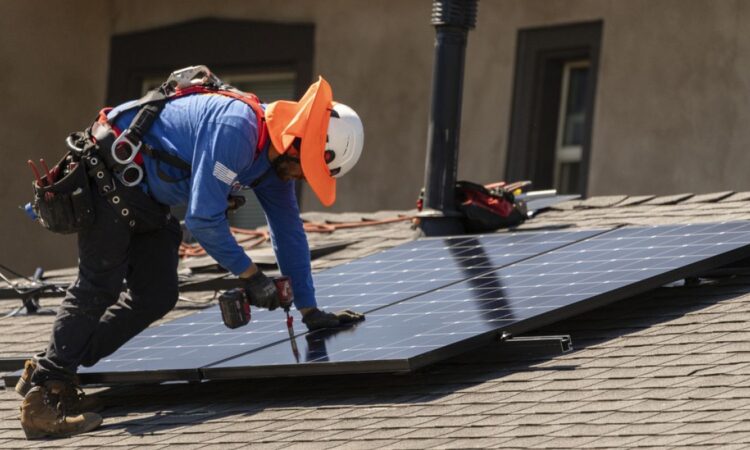
Europe’s energy transition and the EU goal of reaching ‘net-zero’ emissions could be at risk unless the equivalent of 0.4% of GDP is pumped into upgrading electricity distribution systems, the power sector has warned as energy ministers finalise their position on future grid development.
With energy ministers expected to call on the European Commission next week to promote the development of Europe’s power grid, the electricity industry has warned that annual investment in local distribution networks will need to double to some €67bn or risk jeopardising the energy transition.
In a report published on Wednesday (22 May) during its annual conference in Greece, the trade association Eurelectric has concluded that Europe’s transition away from fossil fuels, and its net-zero target, are at stake.
Without investing a sum equivalent to 0.4% of the EU’s annual economic output (GDP) in bolstering distribution grids, it will be impossible to integrate necessary huge new volumes of renewable generation capacity like solar and onshore wind power, the group claims.
Eurelectric’s president, Leonhard Birnbaum, speaking to Euronews on the day of publication, argued that the bulk of the money would come from the capital markets, providing investors can be persuaded that backing this piece of the energy transition jigsaw is in their interests.
For this to happen, though, the regulatory environment will need to be conducive to such long-term investments, he said. “It’s a good deal if it’s a regulated business that offers sufficient returns – most of the money is going to come in the end from grid fees.”
But public money may also also be needed, he acknowledged. “We have now the negotiation for the multi-annual financial framework coming up,” Birnbaum said, referring to the EU’s trillion-euro seven-year budget. “There might be targeted support needed also for distribution, and we have to carefully think where it might make sense to provide – quote unquote – subsidies.”
Distribution grids – as distinct from the high-voltage transmission network that links regions, member states and several neighbours – fan out from the end of cross-country power lines, and route through substations into homes and businesses – and, increasingly, to electric vehicle charging points.
Their regulation is largely a matter for national authorities, but that is not to say political signals from Brussels are unimportant, said Birnbaum, who is also CEO of the German electricity giant E.On. And a strong political signal is expected on 30 May, when energy ministers are due to adopt EU Council conclusions on ‘advancing sustainable electricity grid infrastructure’.
Diplomats agreed the draft text of the non-binding statement at a closed meeting on the same day Eurelectric published its report, with energy ministers having kicked off the debate at an informal summit in Brussels in mid-April.
While the text of their position paper remains subject to potential tweaks before adoption, earlier leaked drafts suggested governments are agreed on the need for a strengthened EU-level framework for planning localised grid development, along with greater transparency and independent oversight.
Birnbaum said he was less concerned about the wording ministers eventually settle on than the message it would send to the European Commission and, more importantly, to national authorities.
“The political signal is extremely important,” he said, noting that the inter-governmental statement would build on the momentum of the Commission’s own ‘action plan for grids’ published in November.
The EU executive said at the time that €584bn would need to be invested just to 2030 to achieve the targeted doubling of transmission capacity as well as upgrading distribution infrastructure, around two-fifths of which is already over 40 years old.
“Just the pure fact that the Council and the Commission has a great action plan, and the Council is now discussing it already – that I think is a is a huge step forward here,” Birnbaum said.
The risk is that deploying additional renewable energy infrastructure in line with EU decarbonisation targets – a 42.5% share of renewable energy and 55% emissions cut by 2030 – could overload the existing networks. Birnbaum argues that this situation could actually prove more costly than expanding the grid, for instance by paying so-called curtailment fees to renewable power generators who are forced to shut down.
Moreover, bottlenecks in some areas – Birnbaum mentioned the UK and the Netherlands – are already leading to delays in connecting wind farms to the distribution network. “If the grid doesn’t keep up with the development, it just means the development stops – because it just makes no sense to connect anything anymore,” he said.
The E.On CEO is less concerned about the demand side, despite frequently voiced concerns that growing numbers of electric cars could overwhelm the grid.
“Actually, e-mobility might even help to stabilise the system if we get bidirectional charging,” he said. With cars spending most of their working lives parked, the potential for tapping a portion of their battery capacity for on-grid electricity storage offers one solution to the intermittency of wind and solar power generation.
“We explicitly welcome, as Eurelectric, the transition on the demand side towards more electricity consumption, because that stabilises the cost of the transition,” Birnbaum said. “If we have more kilowatt hours, you know, the price becomes lower, so it’s actually good if we see more consumption.”






